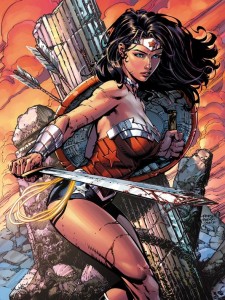I loved watching the “Wonder Woman” TV series when I was a girl. I never wanted to dress like her—the idea of wearing a gold lamé bustier and star-spangled blue underwear all day seemed problematic—but the Amazonian princess was strong and resourceful, with a rope trick for every problem. She seemed to be speaking directly to me, urging, “Go find your own inner Amazonian.” When I read the news that Wonder Woman was going to be resurrected for a blockbuster movie in 2016, Batman vs. Superman, it made me excited—and anxious. Would the producers give her a role as fierce as her origins—and maybe some shoulder straps—or would she just be cartoon eye candy?
The fact that she isn’t even getting billing in the title makes me suspicious. It wouldn’t have pleased Wonder Woman’s creator either. “Wonder Woman is psychological propaganda for the new type of woman who should, I believe, rule the world,” declared the psychologist and comic book writer William Moulton Marston, offering a proto-feminist vision that undoubtedly sounded quite radical in 1943. “Not even girls want to be girls so long as our feminine archetype lacks force, strength and power. Not wanting to be girls, they don’t want to be tender, submissive, peace-loving as good women are.”
Over the years, the writers at DC Comics softened Wonder Woman’s powers in ways that would have infuriated Marston. During the 1960s, she was hardly wondrous at all, less a heroic warrior than the tomboyish girl next-door. It was no longer clear whether she was meant to empower the girls or captivate the boys. But the core brand was still strong enough for Gloria Steinem to put her on the cover of the first newsstand issue of Ms. magazine in 1972—with the slogan “Wonder Woman for President.”






